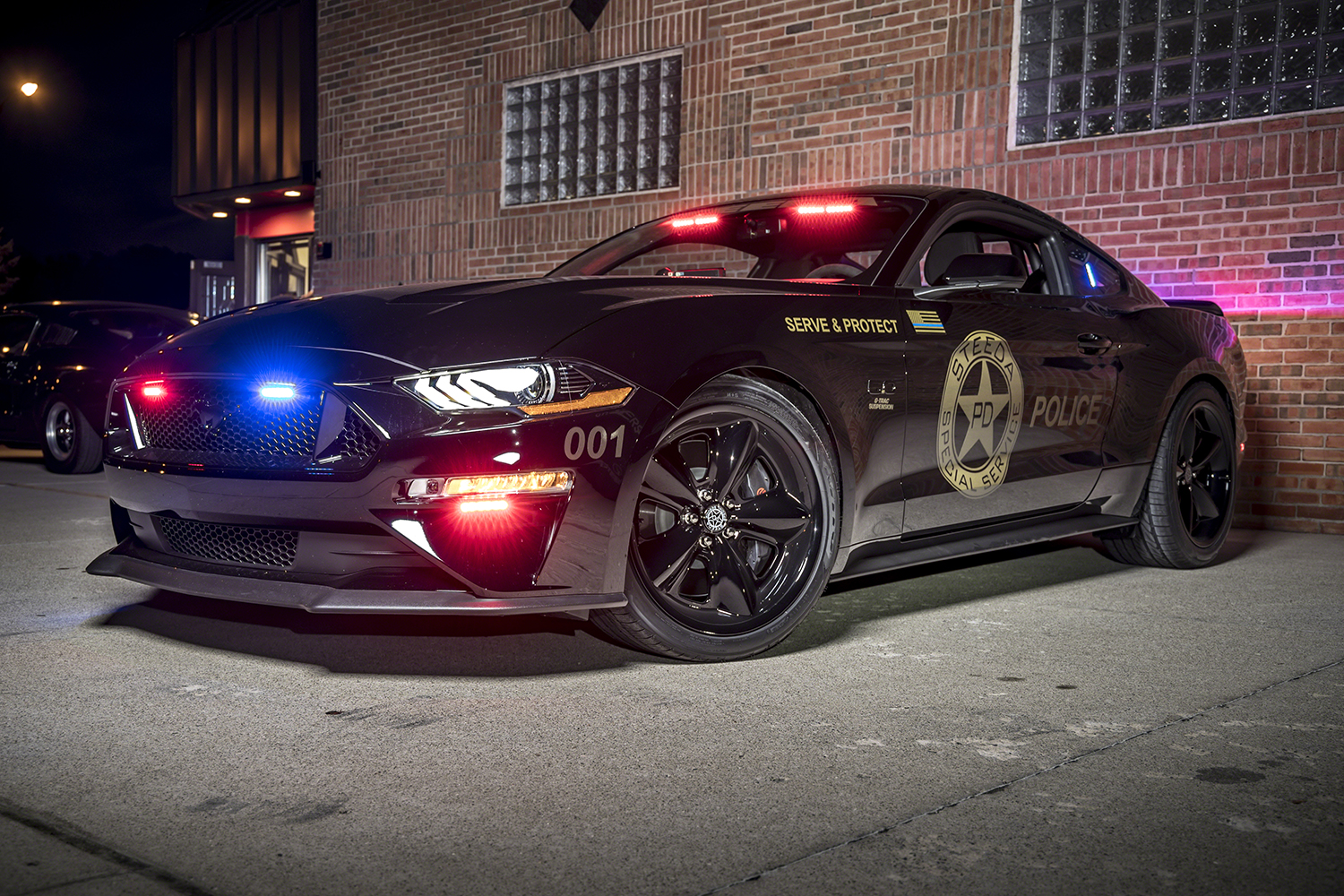Modern police vehicles have become the most capable machines in the history of policing. The culmination of improvements in civilian cars has paid tremendous dividends in police vehicles. The civilian market is also having a tremendous impact on the type of police vehicles that are available for use. With the massive decline in sedan sales auto makers are shifting production capacity to trucks and SUVs and nowhere is this more evident than in the police market. Just a few years ago the big three American automakers each offered sedan-based police cars in various flavors of power output; however, now only Dodge makes a sedan-based police car.
Enforcement vehicles vs special service vehicles
Traditionally called “Pursuit-Rated” vehicles, enforcement vehicles are better equipped for the rigors of sustained high-speed driving and hard braking often associated with traffic enforcement or emergency response. While the number of enforcement vehicles has remained fairly consistent the number of special service vehicles has exploded. Hybrid sedans, vans, and pickups modified for police use cover every drawer in law enforcement’s tool box. These offerings aren’t necessarily suitable for chasing down fleeing felons, rather they are designed to support administrative, traffic control, or evidence recovery. They lack the power, handling capabilities, and braking necessary to support enforcement efforts.
Perhaps one of the biggest improvements in police vehicles is the incorporation of anti-ambush features found on both Dodge and Ford’s enforcement vehicles. By utilizing and repurposing existing vehicle sensor systems both companies are able to provide anti-theft, ambush protection, and situational awareness to the driver. These systems analyze potential human threats approaching from the rear of the vehicle and activate the backup camera and display in the cockpit. Any windows that are down will roll up, and all the doors on the vehicle will lock. Indicators inside the vehicle will show the driver the location of the threat. This feature is available on the Dodge Charger as standard equipment and as an option on the Ford Interceptor Utility.
Patrol load, weight, and power
To get a better idea of how a vehicle will perform it’s better to look at weight per horsepower instead of strictly relying on horsepower numbers alone. In its simplest form the fewer pounds each horsepower has to pull the better the performance of the vehicle. Patrol load plays into these performance numbers as well. For example, a vehicle that has a horsepower to weight ratio of 15.5 pounds per horsepower (15.5:1) compared to another with 14.0 (14.0:1) pounds per horsepower should perform better, all other things being equal.
Chevrolet Tahoe
The Chevrolet Tahoe Police Pursuit Vehicle (PPV) has long been a favorite of departments who need massive amounts of space for equipment or K-9s. It is the largest of the enforcement vehicles and its performance numbers reflect this. The Tahoe PPV tips the scales at 5,480(4WD)/5223(2WD) pounds empty and its 5.3L V8 engine cranks out 355 horsepower and 383 ft./lbs. of torque. A six-speed automatic transmission for both 2-wheel drive and 4-wheel drive versions puts the power to the ground. With a power to weight ratio of 14.7:1 in 2WD trim and 15.4:1 for the 4WD version puts the Tahoe in the bottom fifth of all the enforcement vehicles with a 0 to 60 time of 7.81 and 7.94 seconds. Top speed for the 4WD Tahoe is a scant 120 MPH while the 2WD version is able to swing the speedometer to 134 MPH.
Chances are though, if your department is purchasing the Chevrolet Tahoe it is for its cavernous interior rather than its ability to chase down violators.
Dodge Durango
The Dodge Durango is a relative newcomer to the enforcement vehicle role. Originally found only as a SSV the Durango has now been blessed by Dodge to chase after scofflaws on the road. Available with either a 3.6L V6, or optional 5.7L Hemi, Dodge sends power through an 8-speed transmission to all four wheels via their AWD system. Hemi equipped Durangos get a two-speed AWD transfer case that offers a low-range and high-range AWD capability.
Depending on the engine configuration the Durango rolls across the scales at 4,886-pounds for the V6 and 5,248 pounds for the Hemi, almost as much as a Tahoe. Opting for the more fuel efficient Pentastar V6 (293bhp/260 lb./ft.) costs dearly in acceleration capabilities. The V6 has to haul around 16.7 pounds per horsepower giving it the slowest 0 to 60 time of all the enforcement vehicles at 8.59 seconds.
Despite the extra weight, the Hemi-powered Durango fares much better as the extra grunt of the Hemi (360bhp / 390 lb./ft.) is able to keep the SUV mid pack in terms of acceleration. With a horsepower to weight ratio of 14.6:1 the Hemi Durango clicks off a 0 to 60 at a modest 7.44-seconds.
Dodge Charger
For the first time, the 2021 Dodge Charger is available with two different drivetrains for both V6 and V8 powered cars, making it the most diverse police vehicle currently offered. Previously AWD was not available for V6 models. Vehicle weight starts at 4,097-pounds for the Rear Wheel Drive v6 and maxes out at 4,526-pounds for the Hemi-powered AWD model. All models continue to get Dodge’s 5-speed transmission which probably limits the car’s performance compared to the competition’s 6 and 10-speed transmissions. Even the Durango has an 8-speed transmission mated to the same engine as the Charger.
Acceleration numbers with the Charger show that a lower horsepower to weight ratio is not always the fastest. AWD more than offsets the system’s added weight penalty. The AWD Hemi Charger sprints to 60 MPH in 5.81 seconds despite carrying 12.2-pounds per horsepower. It’s RWD counterpart requires slightly longer at 6.06-seconds according to Michigan State Police (MSP) testing data.
For departments that care more about fuel economy than acceleration the 3.6L Pentastar powered Charger. In RWD configuration the lighter car hauls 14.0 pounds per horsepower to 60 MPH in a tepid 7.7 seconds. AWD drops that number to 7.23-seconds despite a slightly heftier 14.1 power to weight ratio.
Being the only car-based police vehicle has its drawbacks. Departments who want a full-size spare will find that it eats up vast quantities of precious trunk space because it will not fit in the spare tire well. Instead an optional mounting bracket puts the spare under the rear package tray in the trunk.
The Charger comes standard with Dodge’s Officer Protection Pack which utilizes the backup camera and rear parking sensors to detect threats. The system rolls up the windows, locks the doors, honks the horn, flashes the lights, alerts interior chimes, indicates where the potential threat is located, and shows an image from the backup camera. Dodge’s Secure Park feature prevents would-be joy-riders from taking off in the officer’s unattended patrol car. Available ballistic door panels can provide even greater threat protection.
Another technology feature available in the Charger is the Uconnect 12.1-inch touch screen. This integrated display allows the officer’s laptop to be stowed securely in the trunk opening up much-needed space in the cockpit. When combined with a hard mounted keyboard this system provides a more air-bag friendly working environment.
Ford Police Interceptor Utility
Ford’s second-generation Police Interceptor Utility is based on the Ford Explorer and is completely new for 2020. With the demise of the Taurus platform so too are the shared underpinnings that used to support the Explorer. Drivetrain moves from a FWD biased AWD system to a RWD based AWD system. Powertrain options change too with Ford’s first standard hybrid PIU in addition to optional naturally aspirated and turbo-charged powerplants. Regardless of powertrain, all engines are bolted to a 10-speed automatic transmission.
Ford also offers a 12.1-inch integrated touch screen that allows an officer’s laptop to be mounted in the back of the vehicle. Paired with the third generation SYNC system the screen integrates audio controls into the touch screen. Standard with every PIU is Ford’s built-in telematics system that provides vehicle health information and more to fleet managers or supervisors. The first two years of service are complementary with an additional subscription required afterwards.
For an added cost, the Police Interceptor Utility has an available Police Perimeter Alert system that utilizes the Blind Spot Information System (BLIS) to provide 270-degree rear protection from potential threats. This system uses a multiple beam RADAR system which provides greater threat detection distances than competing systems. Upon activation by a detected threat the system closes the vehicle’s windows, sounds an interior chime, locks the doors, activates the rear camera and interior display, and shows the threat location on the instrument cluster display.
The standard Hybrid Police Interceptor Utility tips the scales at a hefty 5,303-pounds making it nearly as heavy as the 4WD Chevy Tahoe. The hybrid’s engine combined with the electric motor generates 318 horsepower and 322 ft./lb. of torque. The drivetrain has to slog 16.7 pounds for every horsepower; however, the 10-speed transmission pays dividends in the acceleration department enabling the second heaviest SUV to click off a 7.2 second 0 to 60 time.
Ford offers a naturally aspirated 3.3L V6 engine. With the loss of the hybrid drivetrain this platform shaves off nearly 550 pounds of battery and electric motor weight. The tradeoff is that without the assistance of an electric motor the engine is only capable of 285 BHP and 260 ft./lb. of torque. When moving the PIU’s 4,755 pounds, the BHP to weight ratio skyrockets to 16.7 pounds. The loss of torque and horsepower places it second to last in acceleration at 8.1 seconds in the 0 to 60 sprint.
If performance and space is your department’s mandate then the Ford PIU Ecoboost may be the right fit for the job. Powered by the new 3.0L Ecoboost V6 drinking 93-octane premium fuel 400 BHP and 415 ft./lb. of torque are on tap. (Expect a drop in output when using lower octane fuel.) The turbocharger hardware and cooling systems do have a slight weight penalty over the naturally aspirated 3.3L engine, in addition to the added cost even above the PIU hybrid. The result is the ability to launch all 4,848-pounds to 60 MPH in a scant 5.43 seconds. With one of the lowest horsepower to weight ratios of 12.1:1, combined with the 10-speed transmission, makes the Ecoboost Police Interceptor Utility the fastest patrol vehicle tested by the MSP.
Final thoughts
Despite the shift to SUVs, the handling properties and performance characteristics are, for the most part, equivalent to, or better than their sedan-based predecessors. When comparing performance numbers, decision factors come down to mission requirements. Do you need more space within your vehicle, or would you like a smaller more maneuverable? Do you want high-tech officer safety features? Regardless of demands and budget, it’s possible to find a vehicle that fits both.
Christopher Ihara is the president and founder of Blacktop Bootcamp Inc. He has been instructing high performance and advanced driving schools since 1997.





